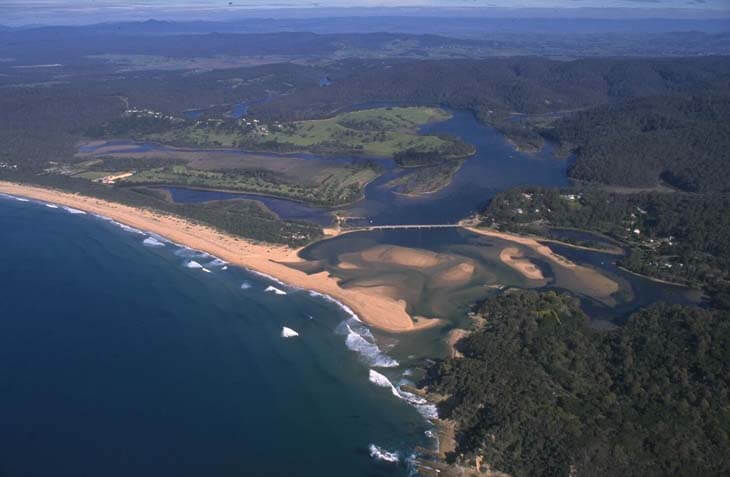Bega River is located on the far south coast of New South Wales, east of the township of Bega. It is classed a barrier river estuary with an intermittently open entrance. The estuary enters the ocean at Mogareeka Inlet.
The main tributaries for Bega River are Brogo River, Upper Brogo River, Bemboka River and Tantawangalo Creek. The area is popular for recreational activities such as fishing and boating.
The estuary supports important habitat, including wetlands, seagrass beds and saltmarsh areas. Three wetlands in the Bega River Catchment are listed in the Directory of Important Wetlands in Australia: the Nunnock Swamp, Bega Swamp and Wallagoot Lagoon.
Water quality report card
As part of our water quality monitoring program we assess the water quality and ecosystem health of an estuary using a range of relevant indicators. We sample a subset of the estuaries between Wollongong and the Victorian border every 3 years. The most recent sampling in the Bega River was completed over the 2020–21 summer, when 2 sites were sampled on a monthly basis.
This report card represents 2 water quality indicators that we routinely measure: the amount of algae present and water clarity. Low levels of these 2 indicators equate with good water quality.
Algae
Water clarity
Overall grade
The report card shows the condition of the estuary was excellent with:
- algae abundance graded excellent (A)
- water clarity graded excellent (A)
- overall estuary health graded excellent (A).
Grades for algae, water clarity and overall are represented as:
- A – excellent
- B – good
- C – fair
- D – poor
- E – very poor.
Go to estuary report cards to find out what each grade means, read our sampling, data analysis and reporting protocols, and find out how we calculate these grades.
We have monitored water quality in the Bega River estuary since 2008. This table shows the water quality grades for this estuary over that time.
| Year | Algae | Water clarity | Overall grade |
|---|---|---|---|
| 2008–09 | C | B | B |
| 2017–18 | B | A | A |
| 2018–19 | B | A | B |
| 2019–20 | B | A | B |
Physical characteristics
| Estuary type | Barrier river |
|---|---|
| Latitude | –36.7 (ºS) |
| Longitude | 149.98 (ºE) |
| Catchment area | 1934.8 km2 |
| Estuary area | 3.8 km2 |
| Estuary volume | 6370.8 ML |
| Average depth | 1.9 m |
Tidal exchange volume
Tidal exchange volume or tidal prism data is available for this estuary. This tidal prism was measured in 2005.
| Tide state | Flow (ML) | Local tidal range (m) | Sydney Harbour tidal range (m) |
|---|---|---|---|
| Ebb flow | 870 | 0.26 | 1.37 |
| Flood flow | 1,400 | 0.31 | 1.28 |
Notes: km2 = square kilometres; m = metres; m3 = cubic metres; ML = megalitres.
Water depth and survey data
Bathymetric and coastal topography data for this estuary are available in our data portal.
Land use
The large catchment of Bega River is moderately disturbed due to 40% of land cleared for grazing. Over half the catchment is forest located in South East Forest National Park. Urban areas, including Bega, make up about 2% of the catchment.
Water use
Find out about water use in the Bega River, including information about major water users, real-time flow data, and environmental and water sharing plans.
National and marine parks
- The largest conservation area in the Bega River catchment is the South East Forests National Park.
- This estuary does not flow into a marine park.
Citizen science projects
- The Far South Coast Conservation Management Network supports the local community to better manage native biodiversity. The network organises citizen science projects, provides information for private landowners, manages a local plant database, and coordinates events.
Community involvement
- The Bega River and Wetlands Landcare Group is a volunteer group dedicated to improving the health of the Bega River, wetlands and floodplains.
- The Far South Coast Landcare Association is a volunteer environmental and conservation organisation that works to improve management of local land and water.

Aerial view of Bega River estuary.
Local government management
Local councils manage estuaries within their area unless the estuary is attached to a marine park.
Bega Valley Shire Council manages this estuary.
Threatened species
The Bega River estuary is an important nesting area for threatened and migratory birds, such as the hooded plover.
Find out more about birds in our estuaries.